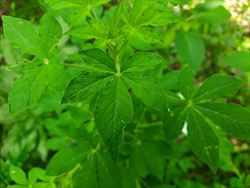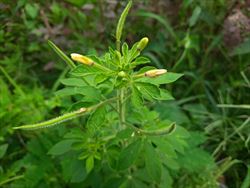Tickweed; it is also known as Asian spider-flower, dog mustard, wild mustard, yellow cleome.
Pacific Pests, Pathogens, Weeds & Pesticides - Online edition
Pacific Pests, Pathogens, Weeds & Pesticides
Tickweed (513)
Cleome viscosa. Previously, it was known as Polanisia viscosa. It is a member of the Cleomaceae, a family closely related to the Brassicaceae.
Asia, Africa, North, South (Ecuador, Venezuela) and Central America, the Caribbean, Europe (France), Oceania. It is recorded from Australia, Cook Islands, Federated States of Micronesia, Fiji, French Polynesia, Guam, Kiribati, Nauru, New Caledonia, New Zealand, Niue, Northern Mariana Islands, Palau, Papua New Guinea, Samoa, Solomon Islands. A native of Asia and, possibly, Australia.
A fast-growing, annual or perennial invasive weed favouring humid, hot environments worldwide, growing on a wide variety of soils - sandy, calcareous, rocky. Found in woodlands, open forests, monsoon forests (alternating wet and dry seasons), grasslands, fallow land, on wasteland and along roadsides. In cultivation, a weed of rice paddies, sugarcane, pastures and orchards. Grows from coastal areas to 800 masl. Invasiveness assisted by seeds without dormancy, germinating readily after shedding, plants that start flowering 3–4 weeks after germination, and a life cycle of about 3 month.
Stems up to 1.5 m, branched or unbranched, hairy, sticky, sometimes woody towards the base. Leaves with three or five oval leaflets (up to 6 cm long, 3.5 cm wide) with hairs on both sides, and coming to a point or rounded at both ends; leaf stalks (petioles) up to 6 cm. Inflorescence (collection of flowers) an unbranched upright stalk up to 40 cm, with three to six flowers on short stalks, each with four oblong to oval, pale to deep yellow petals (8-16 mm long), with rounded tips, some curved inwards (‘clawed’), covered in soft hairs, and surrounding 10 or more stamens (male parts) and a short style with a broad flat-topped stigma (female parts). Flowers have three green, hairy leaflets (3-8 mm long) beneath (the sepals). The flowers open in the morning, closing in the afternoon. Fruit, hairy, sticky, long, up to 10 cm, ridged; seeds round, dark-brown to black when ripe. The plant is overall sticky, and said to have an unpleasant smell.
Spread is by seeds on the wind and in water. Also, contaminant of farm machinery, farm produce, soil, clothes and shoes, even on livestock.
A weed with economic and environmental impact, mostly in rice and sugarcane. It reproduces quickly in a range of environments. Indirect impacts include its role as a host of several important insect pests (e.g., whitefly, Bemisia tabaci; papaya mealybug, Paracoccus marginatus; cotton mealybug, Phenococcus solenopsis; and several important pathogens (e.g., white rust, Albugo candida; Tomato spotted wilt virus; Papaya ringspot virus; and root knot nematodes, Melodogyne species).
Leaves bitter, eaten fresh, dried or cooked; the young fruits are pickled, and the seeds used as a substitute for mustard or cumin in sauces, curries and vegetables. Used medicinally for infections (including intestinal worms), aches and pains. Experimentally, crushed leaves added to cowpea seeds to prevent weevil infestation.
BIOSECURITY
Cleome viscosa has a very wide distribution in the tropics so countries not yet infested are very vulnerable to its introduction. Consequently, they should consider all likely pathways for entry, and apply quarantine measures accordingly. Particular attention should be given to the ease with which the sticky fruits may be detached from plants and stick to clothes, fur, and feathers. There is also the risk of transfers associated with the international trade in medcinal plants. Seed is available for purchase on the Internet.
In the USA, tickweed is declared a noxious weed - a prohibited plant that must be controlled - of no economic purpose and possess characteristics that are harmful to humans, animals or the environment.
BIOCONTROL
No natural enemies have been identified.
CULTURAL CONTROL
Note, infested sites requires vigilance and continuous weed removal..
- Physical & Mechanical:
- Hand weeding (and hoeing) is effective on small areas where follow-up is possible to control seedlings.
- Mulching:
- Maintain a layer of mulch. The seeds are small and seedlings will have difficulty penetrating a 5-10 cm layer of mulch. Use woodchips, grass clippings, etc.
- Hygiene:
- Treat vehicles and farm machinery. If moving from areas where the weed occurs to those weed-free, wash to remove soil and seed. This is equally important if the machinery is being imported into a country or moved within a country.
- If practical, check clothing for seeds after working in an infested area; fence infestations before attempting treatments to prevent further spread by wild animals and livestock.
CHEMICAL CONTROL
CABI lists several herbicides for the control of tickweed: monolinuron, trifluralin, metribuzin, diuron, oxadiazon, chlorbromuron, atrazine, prometryne, terbutryne. The first five are registered in Australia, but only metribuzin is registered in the EU. Other herbicides that have been suggested are 2,4-D, dicamba and MCPA, all of which are registered in both Australia and the EU. In Fiji, glyphosate is recommended.
--------------------
Note, EU approval to use glyphosate ends in December 2022; its use after that date is under discussion.
____________________
When using a pesticide, always wear protective clothing and follow the instructions on the product label, such as dosage, timing of application, and pre-harvest interval. Recommendations will vary with the crop and system of cultivation. Expert advice on the most appropriate herbicides to use should always be sought from local agricultural authorities.
AUTHORS Grahame Jackson & Makereta Ranadi
Information from Cleome viscosa L. Atlas of living Australia. (https://bie.ala.org.au/species/https://id.biodiversity.org.au/node/apni/2892748#names); and CABI (2021) Cleome viscosa (Asian spiderflower). Crop Protection Compendium. (https://www.cabi.org/cpc/datasheet/14045); and Cleome viscosa (2021) Wikipedia. (https://en.wikipedia.org/wiki/Cleome_viscosa); and Unknown (2007) Cleome viscosa. Electronic flora of South Australia. Department of Land and Water, Government of South Australia. (http://flora.sa.gov.au/cgi-bin/speciesfacts_display.cgi?form=speciesfacts&name=Cleome_viscosa); and Fern K (2021) Cleome viscosa L. Tropical Plants Database. (https://tropical.theferns.info/viewtropical.php?id=Cleome+viscosa); and CSIRO (2020 Cleome viscosa. Australian Tropical Rainforest Plants. (https://apps.lucidcentral.org/rainforest/text/entities/cleome_viscosa.htm); and Cleome viscosa (PROTA) (2021) Pl@nt Use. (https://uses.plantnet-project.org/en/Cleome_viscosa_(PROTA); and from CABI (2015) Cleome viscosa (Asian spiderflower). Invasive Species Compendium. (https://www.cabi.org/isc/datasheet/14045). Photo 1 Plague (2021) Flower buds and fruits of Cleome viscosa. (https://commons.wikimedia.org/wiki/File:Cleome_viscosa_l.jpg). Photo 2 Kevin Thiele (2012) KRT4566. From Perth, Australia. (https://commons.wikimedia.org/wiki/File:Cleome_viscosa_(7596847412).jpg). Photo 3 Plague (2021) Leaf of Cleome viscosa. (https://commons.wikimedia.org/wiki/File:Cleome_viscosa_lab.jpg).
Produced with support from the Australian Centre for International Agricultural Research under project HORT/2016/185: Responding to emerging pest and disease threats to horticulture in the Pacific islands, implemented by the University of Queensland, in association with the Pacific Community and Koronivia Research Station, Ministry of Agriculture, Fiji.






